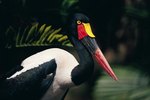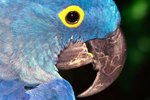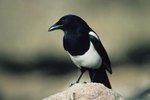
Man has discovered and documented about 9,800 currently living bird species. Among them all, just about every naturally occurring substance on Earth is a potential food source for these beaked, egg-laying, feathered creatures. All bird species have a beak adapted to acquiring, handling and consuming their particular foods. Numerous types of beaks are seen, but the majority of birds may be classified as having one of six main styles.
Hooked Beaks
Birds of prey and birds that scavenge carrion, including eagles, hawks, falcons, ospreys, owls, vultures and buzzards, have hooked beaks. The upper portion of the beak curves down over the lower portion and comes to a sharp point. These beaks are designed for fatally biting prey and tearing flesh.
Cracker Beaks
Birds that eat primarily nuts and seeds have short, conical beaks that are widest at the base. These are made to crack open shells and extract the inner nut or seed meat. Sparrows, finches, cardinals, bluejays, grosbeaks and juncos are examples of birds with cracker-style beaks.
Tweezer Beaks
Some species of birds rely on insects for sustenance. These typically have relatively thin tweezer-like beaks that easily pick up and hold on to insects. Warblers, wrens and orioles are well-known examples of insectivorous birds with this type of beak.
Strainer Beaks
Ducks and other birds that spend much of their time on the water, and whose diets consist primarily of water plants and aquatic invertebrates, usually have strainer-style beaks. They filter food out of mouthfuls of water, sand and other water debris. These are elongated, flat bills with ridged edges, internal comb-like structures or other means of filtering food.
Probing Beaks
Probing beaks are long and slender, designed primarily for getting at nectar inside flowers. Many even resemble straws, and they're generally accompanied by long thin tongues. Hummingbirds are undoubtedly the most famous bird species sporting probe-style beaks. Sunbirds, spinebills, and several types of honeyeaters have probing beaks too.
Spear Beaks
Herons, terns, kingfishers, egrets and other fish-eating birds have spear-like beaks designed for stabbing fish. Some dive at fish while others stand in the water waiting for prey to swim by.
Other Beak Styles
Of course, lots of other types of beaks exist. Pelicans are famous for their pouched beaks that hold up to 9 gallons of water and fish. Woodpeckers are known for their chisel beaks that peck holes into trees in the search for tasty insects living beneath the bark. Because crows eat just about anything, including carrion, nuts and seeds, fruit, fish and insects, they have what can perhaps best be described as the Swiss Army knife of beaks, adapted to doing whatever they need them for.
References
Photo Credits
-
Tom Brakefield/Stockbyte/Getty Images
Writer Bio
Eric Mohrman has been a freelance writer since 2007, focusing on travel, food and lifestyle stories. His creative writing is also widely published. He lives in Orlando, Florida.




